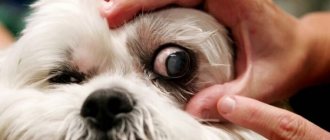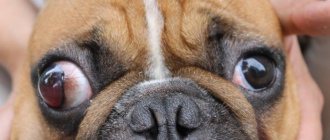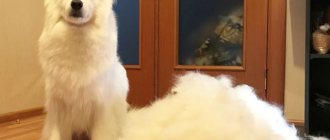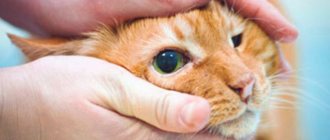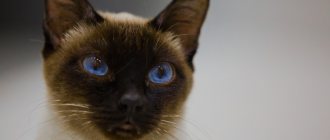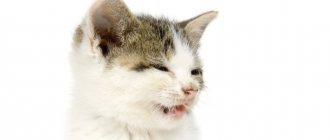In the article I will look at the main causes and symptoms of proptosis, a disease accompanied by prolapse of the eyeball in dogs. Reasons why eyes fall out or fall out. I will explain how the treatment works and what preventive measures should be taken by owners of breeds at risk.
Main symptoms
The prolapsed eye looks bulging, it extends beyond the eyelids, because of this, for a short period, the tissues around the eye become swollen, red, and very painful. In this case, the dog cannot blink, as a result of which the cornea (the outer transparent layer of the eye) develops. The dog becomes passive and often tries to scratch its eye with its paw.
If these symptoms are present, you should take your pet to a veterinarian as soon as possible, since hours and even minutes are counting, and there is a high risk of losing not only vision, but also the eye itself.
Pros and cons of the Shih Tzu
Among the advantages of the breed are the Shih Tzu's diminutiveness, sociability and love of being in the company of people. Therefore, they are perfect for keeping in city apartments.
Kids do not need regular physical activity; daily walks in the fresh air are enough, which is convenient for older owners. But if it is not possible to walk your pet, he can easily get by with a tray. The main thing is to accustom the baby to it from the first days of being in the house.
The main disadvantages of the Shih Tzu:
- difficulties in caring for the coat - you cannot do without professional grooming;
- eye problems - protrusion of the eyeballs, tendency to inflammatory diseases;
- tendency to swallow fur, which can form lumps in the esophagus, causing dangerous consequences, including suffocation.
Due to the nature of their fur, dogs do not tolerate heat well, so in the summer it is better to be outside with them in the morning and evening. Excessive activity on a hot day can lead to heatstroke. Shih Tzus are poor swimmers and do not like water procedures, although they quickly get used to regular bathing.
pixabay.com/RobynRandell
First aid for proptosis in dogs
It is important that the dog does not try to scratch the eye with its paws and does not rub its head against surrounding objects, this can lead to even greater trauma and an increased risk of vision loss. To do this, you can wear a special protective (Elizabethan) collar. If there is no collar, you can carefully secure your pet’s paws or head with your hands or a towel.
If eye prolapse is detected and on the way to the veterinary clinic, you should rinse (and thereby moisten) the eye with sterile warm saline every 5-10 minutes. In the pharmacy it is called sodium chloride 0.9%. To rinse, you need to take a syringe with a volume of 5 or 10 ml, fill it with saline solution (or warm boiled water, if there is no sodium chloride), remove the needle and carefully water the eye. Antibacterial eye drops or moisturizing eye gels (Korneregel, Vidisik, Oftagel and others) are also suitable.
You cannot use solutions such as chlorhexidine, hydrogen peroxide, Miramistin and other antiseptics, as they can cause a burn to the cornea!
What absolutely should not be done
Under no circumstances should you try to straighten the eye with your own hands, much less allow dirt to get into the wound. Do not hesitate to contact the veterinary clinic, because delay can cost your dog’s sight.
It is necessary to observe preventive measures: do not walk in thickets of grass and dusty places. The collar should not put too much pressure on the neck.
Urgent veterinary assistance required
An experienced dog handler knows well which dogs have eye loss and remembers the list of breeds prone to this pathology. A dog whose eyes are bulging out needs good care and qualified veterinary care.
Diagnosis of eye loss
At the appointment, the doctor will examine the patient and announce prognoses regarding vision. An ophthalmologist will conduct tests and evaluate reflexes that will help understand the extent of damage:
- pupil reaction to light,
- blinding reflex,
- examination of the fundus using a special ophthalmoscope device,
- Ultrasound of the eye to evaluate internal damage or detachment of the retina (the inner lining of the eye that transmits visual information through the optic nerve to the brain).
The prognosis is considered good if:
- presence of vision,
- preservation of pupillary reflexes,
- reactions to blinding light,
- positive ophthalmoscopy data,
- rupture of less than two muscles that hold the eye in the orbit,
- lack of blood inside the eye.
Signs that give an unfavorable prognosis for the preservation of vision and the eye as an organ: no reaction of the pupil to light, retinal detachment is observed (according to the results of ophthalmoscopy and ultrasound), more than 2 muscles are damaged, there is a rupture of the structures of the eye or hemorrhage inside it.
Preventive actions
If a dog has been adopted with drooping eyelids and a genetic predisposition to proptosis, the owner of such a pet should regularly take preventive measures to prevent the disease. These are simple measures that will help significantly reduce the likelihood of pathology:
- Neither puppies, nor adults, nor even small pets should be picked up by the scruff of the neck, much less carried in this state.
- Animals with a distinctive structure of the skull and muzzle, when the eyes are too close or there is weakness in the muscle fibers, are not recommended to be allowed to play with other animals or small children.
- Regular eye hygiene procedures.
- It is necessary to remove household items or toys with sharp edges from the room in which the pet is located. These can cause damage to the animal's eyes.
- Pekingese, which have a very high predisposition to proptosis, are best carried from high floors by hand. Frequently climbing stairs increases the risk of developing ophthalmological diseases.
Walking on the street is carried out on a leash so that it is possible to control the pet’s behavior.
One of the radical methods of prevention is canthoplasty. This is a surgical intervention, the essence of which is to reduce the ocular incision, due to which the organ of vision is better protected from the occurrence of proptosis.
Proptosis is a common disease; many animals have a genetic predisposition. Due to the commonality of provoking factors for the appearance of pathology, it is necessary to carry out preventive work to prevent the disease, often resorting to a drastic measure - surgery. Otherwise, there is a risk that the pet will lose an eye.
Treatment of proptosis in dogs
After determining the condition of the eye, surgery is performed to realign it. This procedure is performed under general anesthesia.
The eye is set by temporarily suturing the eyelids, which helps keep it in its normal position and speed up healing. Doctors try to save the eye even with poor prognosis. This is because signs such as lack of pupillary response to light may be temporary, and reduction is a less traumatic procedure than removal of the eye, which can be done electively at a later date. In the postoperative period, eye drops and tablets containing antibiotics, anti-inflammatory drugs to relieve swelling and pain, and a protective collar are used. After 14 days, the sutures from the eyelids are removed and the condition of the eye is re-evaluated.
Causes
The main cause of this kind of illness is traumatic or mechanical damage. In theory, almost any breed of dog can encounter this, but in practice, such an injury is typical with such a structure of the skull, when the eyeball is fixed only by the eyelids (therefore it is very mobile).
When the eyeball is displaced, a rupture of the rectus muscles and a retrobulbar hematoma are noted.
Eye injury causes damage to all parts of the visual apparatus - membranes, intraocular vessels, lens and vitreous body.
This disease is manifested by the following symptoms:
- protrusion of the eyeball;
- bruising and bleeding on mucous membranes;
- conjunctivitis and swelling.
Changes in the optic nerve are often the cause of blindness.
Consequences of eye loss
With a small amount of damage, preservation of reflexes and quick delivery of the pet to the veterinary clinic, such an eye will be able to continue to see (of course, after the stitches are removed).
If the eye has lost function due to loss, but there are no ruptures, internal bleeding, reflexes are preserved, and there is no dryness of the cornea (which can occur after damage to the glands that produce tears), then the doctor can leave such an eye under observation.
Removal is performed only with progressive deterioration of the eye condition.
If the eye is severely damaged due to proptosis (there are ruptures of many muscles and other structures, hemorrhages), then removal may be recommended immediately or a few days after the loss. The doctor makes a decision based on an assessment of the dog's condition. If your general health is poor or there are injuries to other organs, eye surgery may be postponed until the patient’s well-being has stabilized.
Prevention measures
The following measures will help prevent this problem from occurring:
- carrying out preventive plastic surgery to suturing the palpebral fissure - such an event does not completely exclude the occurrence of ocular proptosis, but significantly reduces the likelihood of developing this disease;
- preventing conflicts between the pet and its fellows;
- protecting the animal from dangerous games;
- removal of sharp objects from the home;
- preventing your pet from being in tall thickets during walks;
- avoiding stretching of the skin on the neck and head - you cannot take the dog by the scruff of the neck;
- instilling antibacterial agents into the animal’s eyes before going for a walk and upon returning home;
- ensuring regular preventive veterinary examinations.
Pug on a walk
You should not be afraid to have short-faced dogs just because of their predisposition to developing proptosis of the eyeball. The anatomical features of the muzzle of these animals do not always lead to the appearance of the disease. Maximum care and respect for your pet almost completely eliminates the risk of this problem; even if it does occur, competent actions will help solve it quickly and without any consequences.
Lens diseases
One of the most terrible and dangerous diseases is problems with the lens . They are difficult to treat and affect the most important part of the ocular apparatus.
Cataract
The second name is “Gray Star”. The disease is determined by the opacity of the lens capsule (full or partial). Cataracts are divided into primary and secondary.
- Primary – a congenital or hereditary change in the lens, which manifests itself at 5-6 years of a pet’s life. It appears without any trauma or other reasons.
- Secondary – acquired as a result of anomalies and deformations of the eyes, infectious untreated diseases, diabetes mellitus. There is no cure. Most often, cloudiness is called an eyesore for a dog.
